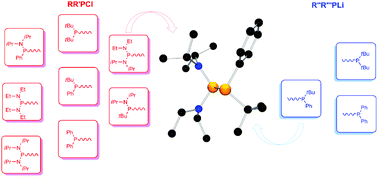Symmetrical and unsymmetrical diphosphanes with diversified alkyl, aryl, and amino substituents†
Abstract
We present the comprehensive study of diphosphanes with diversified substituents regarding their syntheses, structures, and properties. To this end, we have synthesized a series of novel unsymmetrical alkyl, aryl and amino-substituted diphosphanes of the general formula R1R2P-PR3R4 (where R1, R2, R3, R4 = tBu, Ph, Et2N or iPr2N) via a salt metathesis reaction of halophosphanes with metal phosphides in high yield. We vastly expanded this group of compounds by obtaining the first mono- and tri-amino-substituted systems. The structures of the isolated compounds were characterized by NMR spectroscopy and X-ray diffraction. The isolated unsymmetrical diphosphanes have no tendency to rearrange to the corresponding symmetrical species. Additionally, we proposed the general classification of diphosphanes based on the number of different groups attached to phosphorus atoms and their distribution within a molecule. To investigate the impact of substituents on the properties of P-centers and a molecule as a whole, we conducted a DFT study on the electronic and steric properties of the obtained systems. The experimental and theoretical results can be very useful for designing P–P systems with desired properties.



 Please wait while we load your content...
Please wait while we load your content...